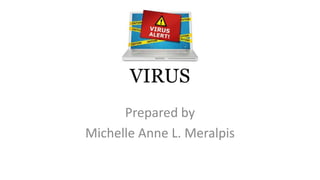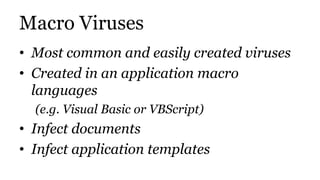Virus - Ethics report
- 1. VIRUS Prepared by Michelle Anne L. Meralpis
- 2. What is Computer Virus? âĒ Computer viruses are small software programs that are designed to spread from one computer to another and to interfere with computer operation.
- 3. Spreading of Viruses âĒ Usually disguised as something else (e.g. Instant Messaging messages, Funny images, Audio and Video Files, Downloading files from Internet, Greeting cards and many more.) âĒ Cause unexpected and usually undesirable events
- 4. Spreading of Viruses (cont.) âĒ Often attached to files âĒ Deliver a âpayloadâ (e.g. display a message, delete or modify a document, reformat hard drive)
- 5. Spreading of Viruses (cont.) âĒ Does not spread itself from computer to computer â Must be passed on to other users through: âĒ Infected e-mail document attachments âĒ Programs on flash drives âĒ Shared files
- 6. Macro Viruses âĒ Most common and easily created viruses âĒ Created in an application macro languages (e.g. Visual Basic or VBScript) âĒ Infect documents âĒ Infect application templates
- 7. Famous Virus: Melissa Melissa attacked computers in March 1999, infecting machines when users opened a Word document attachment. Through the effect the virus had on individualsâ computers was minimal, users of Outlook Express unintentionally sent virus on to first 50 people who where in their Global Address Book. For companies, however, the virus had a larger impact. The virus was sent to users with the subject âImportant message from [name].â More than a million users were infected, the BBC reported. Also caused $80 million in damage, and was first virus to travel through e-mail.
- 9. Prevention âĒ Use an Internet firewall âĒ Subscribe to industry standard antivirus software âĒ Never open an e-mail attachment from someone you donât know âĒ Scan each and every attachment
- 10. Prevention (cont.) âĒ Back-up critical applications and data regularly







![Famous Virus: Melissa
Melissa attacked computers in March 1999, infecting machines when
users opened a Word document attachment.
Through the effect the virus had on individualsâ computers was
minimal, users of Outlook Express unintentionally sent virus on to
first 50 people who where in their Global Address Book.
For companies, however, the virus had a larger impact.
The virus was sent to users with the subject âImportant message from
[name].â
More than a million users were infected, the BBC reported.
Also caused $80 million in damage, and was first virus to travel
through e-mail.](https://image.slidesharecdn.com/ethics-virusmeralpis-140706031621-phpapp01/85/Virus-Ethics-report-7-320.jpg)



